How do you remember which cast is for which wind?
It’s easy, just remember D/D and this will remind you of the phrase “Double Spey, Downstream wind”. Therefore it is easier to remember that a Single Spey and its counterparts are simply the opposite.
As with all Spey casts, the Double Spey can be used when there is no wind at all, however it is a very safe and efficient cast when used in a downstream wind.
In articles 3 and 4, we looked at the Single Spey cast and its counterparts the Snap T and Circle C, which as previously explained perform better and safer when there is an upstream wind in attendance. That’s all well and good, but the next time you visit the river you may find that the wind has turned full circle presenting you with a downstream wind situation. This can also occur mid way down a pool where you have been fishing quite happily with a Single Spey cast in an upstream wind, then suddenly the wind changes to blow in a downstream direction, causing all sorts of problems. “What do you do”?
Most of us will have experienced both of the above scenarios at some stage during one or more of our fishing trips. However, to combat these situations, we need to be able to transfer our D Loop to the opposite side of our body at the drop of a hat for a much safer and more efficient cast, whilst at the same time using the new wind direction to our advantage. “Enter the Double Spey cast”.
In article 1 The Basic Roll Cast, I explained that the mechanics of Spey Casting relate to both single and double handed fly rods. Therefore, as I have mainly used pictures of single handed rods in previous articles I would like to back this statement up by making reference to double handed rods in the remaining two articles. An essential requirement for the double handed caster is the ability to use either hand uppermost on the rod handle where required, (as explained in article 3) dependant upon which bank you are fishing from (left & right banks of the river are also explained in article 3 The Single Spey Cast). The differences between the Single Spey grip and the Double Spey grip, (when holding a double handed fly rod) are as follows:
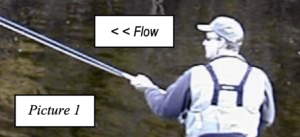 In contrast to the Single Spey cast, if you are on the left bank of the river when executing a Double Spey cast, place your left hand uppermost on the rod handle, (picture 1) and if you are on the right bank of the river, place your right hand uppermost on the rod handle (picture 2). This not only allows you to set up your cast more comfortably, but also prevents you from crossing your hands over just prior to the forward delivery, enabling you to open up to your cast more efficiently during the formation of your D Loop.
In contrast to the Single Spey cast, if you are on the left bank of the river when executing a Double Spey cast, place your left hand uppermost on the rod handle, (picture 1) and if you are on the right bank of the river, place your right hand uppermost on the rod handle (picture 2). This not only allows you to set up your cast more comfortably, but also prevents you from crossing your hands over just prior to the forward delivery, enabling you to open up to your cast more efficiently during the formation of your D Loop. 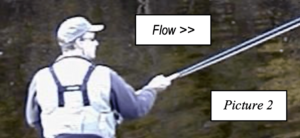 This approach also presents you with a much longer casting stroke, (where required) and assists with better tracking on the forward delivery (keeping your cast straight). Although this cast “can” be made with your hands crossed prior to the delivery, (e.g. back handed) doing this will not allow you to realise the full potential of your delivery (due to its restriction) and you will be more inclined to pull the rod across your body during the forward stroke, creating the aforementioned tracking problem (as explained in article 3).
This approach also presents you with a much longer casting stroke, (where required) and assists with better tracking on the forward delivery (keeping your cast straight). Although this cast “can” be made with your hands crossed prior to the delivery, (e.g. back handed) doing this will not allow you to realise the full potential of your delivery (due to its restriction) and you will be more inclined to pull the rod across your body during the forward stroke, creating the aforementioned tracking problem (as explained in article 3).
The Double Spey cast is so called because it consists of two movements of the rod tip. These movements occur between the initial lift and the delivery of the cast, e.g. an upstream movement and a downstream movement. So this in mind, let’s now take a look at the mechanics of this cast using the double handed fly rod.
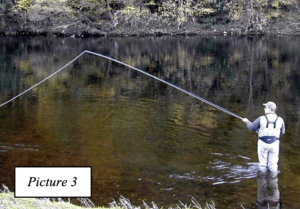 As with all Spey casts we start with the lift, which you should now be familiar with if you have been following these articles in sequence. In this instance I am on the left bank of the river, (picture 3) therefore my left hand is uppermost on the rod handle, (as discussed above) because of this I am also placing my left foot slightly forward. This is ergonomically sound, and as described in previous articles, will (amongst other things) help prevent your body from swivelling too far around when creating your D Loop. “Where possible, I always like to place my corresponding foot forward a little when setting up a cast” however, alternatives are available and often necessary.
As with all Spey casts we start with the lift, which you should now be familiar with if you have been following these articles in sequence. In this instance I am on the left bank of the river, (picture 3) therefore my left hand is uppermost on the rod handle, (as discussed above) because of this I am also placing my left foot slightly forward. This is ergonomically sound, and as described in previous articles, will (amongst other things) help prevent your body from swivelling too far around when creating your D Loop. “Where possible, I always like to place my corresponding foot forward a little when setting up a cast” however, alternatives are available and often necessary.
Additional Information (Stance)
As mentioned previously in the “Roll Cast”, It should be noted that some casters may adopt a neutral stance, (e.g. both feet placed together) this may be born out of necessity depending where you are situated in the river, or some more advanced caster may even purposely open up their stance, (i.e. place their other foot forward) deliberately affording them more body rotation and therefore a longer casting stroke, (where required) “e.g. casting longer lines for instance”, also allowing them to see their anchor placement better on the water. However, these casters understand the inherent problems that this may incur when setting up a cast and can easily compensate for that. “When learning these casts for the first time, keep it simple”.
At this stage, (where possible) make sure your fly is fished out close to your own bank, prior to the initial lift you are about to do. Apart from the obvious advantage of this, i.e. your fly having covered the maximum amount of water to get to this position in the first place, it will also improve the cast from the outset, especially when we introduce the upstream sweep. Why? because your fly line, leader and fly are now closer to your bank, therefore your anchor point can also be drawn closer to you (on your downstream side) during the upstream sweep. This in turn allows you to maximize your D Loop much more efficiently prior to the forward delivery. Starting the upstream sweep with your fly too far out in the river often results in poor anchor placement, too much fly line on the water surface prior to the delivery of your cast, and ultimately a much smaller, inefficient D Loop.
Additional Information
As your understanding of the mechanics of this cast improves, you may purposely place your anchor further out into the river to create the above scenario, i.e. a D Loop that does not extend back as far prior to the delivery of your cast. This can be very useful when obstacles behind you are very close and problematic. However, as this is a slightly more advanced technique it should be visited at a later date as the timing of your cast will also need to change for a successful outcome).
Ok let’s get started with The Lift
As discussed previously, starting with the rod tip pointing downstream towards the fished out fly, raise the rod tip to 45° (the lift) to releases some of your fly line from the water surface ready for the next stage of the cast (picture 3). It is at this stage that we now introduce the double movement (discussed earlier) with the rod tip (the upstream sweep and the downstream sweep).
Additional Information
Before continuing I should point out that there are several ways of creating a Double Spey cast for a variety of situations, but for the purposes of this article we will stick to one method to prevent confusion.
The Upstream Sweep
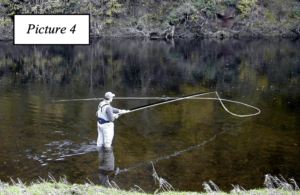 The next objective (after the lift) is to draw the fly line, leader and fly in an upstream direction (from its fished out position downstream). This movement is essential to helping you place your fly and leader into the correct position on the water, (i.e. a rod to a rod and a half length downstream of you and out to the side of your casting shoulder) prior to the delivery of your cast (your anchor point position) (picture 4). This upstream sweep does two things, a) it brings your fly upstream into the required position on the water, (as indicated above) and b) it creates some spare fly line upstream of you which you will later require to create your D Loop when you eventually make your downstream sweep (if you look at the shape of the fly line on the water above you, (picture 4) it is actually already in the shape of a D Loop laid on its side. It is this D Loop that simply needs to be transferred to your downstream side to create your desired casting weight prior to the delivery of your cast). You are now ready for the second part of the double movement, “the downstream sweep”.
The next objective (after the lift) is to draw the fly line, leader and fly in an upstream direction (from its fished out position downstream). This movement is essential to helping you place your fly and leader into the correct position on the water, (i.e. a rod to a rod and a half length downstream of you and out to the side of your casting shoulder) prior to the delivery of your cast (your anchor point position) (picture 4). This upstream sweep does two things, a) it brings your fly upstream into the required position on the water, (as indicated above) and b) it creates some spare fly line upstream of you which you will later require to create your D Loop when you eventually make your downstream sweep (if you look at the shape of the fly line on the water above you, (picture 4) it is actually already in the shape of a D Loop laid on its side. It is this D Loop that simply needs to be transferred to your downstream side to create your desired casting weight prior to the delivery of your cast). You are now ready for the second part of the double movement, “the downstream sweep”.
Additional Information
The position to which you place your fly on the water, by way of this upstream sweep, will ultimately be dictated by the angle to which you wish to deliver the cast. E.g. if you are facing 45° across the river for a 45° cast then your casting shoulder, and therefore your desired anchor point position, will be different to that of a cast you wish to make to 90° across the river (as in picture 4). This is because if you intend to cast 90° across the river you will initially be facing 90° prior to the set up of your cast, (as in picture 4) therefore your casting shoulder will obviously be in a different place. If all this sounds complicated, the easiest way to identify your anchor point position (for this cast) is: first of all face the opposite bank of the river, place your rod flat across your body, with your rod tip pointing downstream, now wherever you decide to turn to face your intended target, your rod tip will follow. Wherever your rod tip is now pointing to when facing your intended target is the position your anchor point should be prior to delivering the cast.
The Downstream Sweep
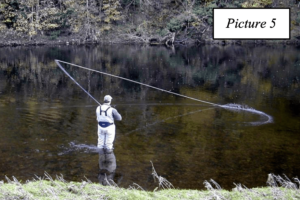 Before starting the downstream sweep, make sure that your rod tip starts from a low position upstream of you (picture 4) (preferably just above the water surface). This allows you to do two things as you begin this downstream sweep (picture 5) a) to use the water surface to stay in touch with your fly line (line tension) and b) by starting the cast from a low position it makes it easier to continuously climb into your D loop (see further information below). Ok, start the downstream sweep movement relatively slowly from the outset, becoming progressively faster as the line peels from the water surface, but not so fast that the line rips from the water. Remember all you are trying to do is maintain line tension throughout this downstream acceleration, (no slack line in the system) whilst ultimately creating your D Loop on the downstream side, too fast and you will introduce slack line into your D Loop just prior to the delivery, as this often compels you to force the D Loop in at the end of the sweep by introducing a kick into the cast as apposed to just letting it form naturally, too slow and you will not have generated enough momentum to pick up all the fly line from the water, resulting in an inefficient D Loop, e.g. too much line left in the water (line stick) prior to the delivery, resulting in a failed cast.
Before starting the downstream sweep, make sure that your rod tip starts from a low position upstream of you (picture 4) (preferably just above the water surface). This allows you to do two things as you begin this downstream sweep (picture 5) a) to use the water surface to stay in touch with your fly line (line tension) and b) by starting the cast from a low position it makes it easier to continuously climb into your D loop (see further information below). Ok, start the downstream sweep movement relatively slowly from the outset, becoming progressively faster as the line peels from the water surface, but not so fast that the line rips from the water. Remember all you are trying to do is maintain line tension throughout this downstream acceleration, (no slack line in the system) whilst ultimately creating your D Loop on the downstream side, too fast and you will introduce slack line into your D Loop just prior to the delivery, as this often compels you to force the D Loop in at the end of the sweep by introducing a kick into the cast as apposed to just letting it form naturally, too slow and you will not have generated enough momentum to pick up all the fly line from the water, resulting in an inefficient D Loop, e.g. too much line left in the water (line stick) prior to the delivery, resulting in a failed cast.
Additional Information
As mentioned above, it is important to start the downstream sweep with your rod tip in a low position from the outset, this allows you to climb up an imaginary spiral staircase during the sweep (See Note: page 4 below). This will also allow you to release the maximum amount of line from the water surface in an upward direction, therefore delaying the fly line from falling toward the water behind you whilst creating your D Loop, affording you more time to make the forward delivery.
If you prefer something visual to focus on when executing this cast, then just watch the water skier effect (or spray) that the fly line creates on the water surface during the downstream sweep, the beginning of which can be seen in (picture 5). If executed correctly, as soon as this spray stops, the D Loop will be formed and the delivery must be made. If you wait too long before delivering the cast then the D Loop will collapse behind you and your fly line will stick in the water surface causing a loud slurping noise when you try to deliver the cast and ruining the end product. If you deliver the cast too soon you will then hear a loud click, this will be your fly flicking upward and backwards in the air, telling you that you have tried to deliver the cast whilst the fly line is still moving, therefore speeding it up, as apposed to allowing your fly (anchor point) to lock in to the water surface prior to the forward delivery, this will also ruin your cast.
Tip
“If you hear the click you’ve gone too quick”. Many of these noises, including those we discussed in article 1 (The Basic Roll cast) are excellent indicators of what is happening throughout all stages of the cast, use them to your advantage, especially when something has gone wrong with your cast, as this will eventually become a fast track to a better understanding of what that is. “Fault Finding”.
The D Loop
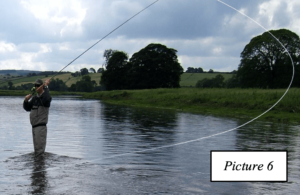 Maximizing your D Loop wherever possible must be one of your main priorities (where room is available) when setting up a Spey cast. It is this D Loop that creates the required casting weight behind the rod tip (prior to the forward delivery) that helps you to load the rod efficiently in the forward stroke, thus allowing you to get the most from your cast. Therefore, the more fly line you can place in the D Loop, whilst still maintaining a good anchor point position on the water, the better your cast will be (picture 6).
Maximizing your D Loop wherever possible must be one of your main priorities (where room is available) when setting up a Spey cast. It is this D Loop that creates the required casting weight behind the rod tip (prior to the forward delivery) that helps you to load the rod efficiently in the forward stroke, thus allowing you to get the most from your cast. Therefore, the more fly line you can place in the D Loop, whilst still maintaining a good anchor point position on the water, the better your cast will be (picture 6).
All this considered and assuming that your anchor point has been set correctly. As soon as the water skier effect, (as discussed above) has stopped, (following the downstream sweep) the D Loop will be formed and ready to go. Make sure (where possible) that the rod tip has been taken back to 45°, (pictures 6&7) also ensuring it is slightly canted out to the side of your body for a safer, more efficient cast. Although we have discussed this in previous articles, it is worth revisiting this outward cant of the rod tip (pictures 6&7). Not only does this keep the cast safe, but it also helps you to maintain a straight line path of the rod tip during the forward casting stroke, which is very important. If you sweep the rod tip around and behind your back when setting up the cast, you will tend to either swing the rod during the forward delivery, taking it off a straight line path, causing what is known as a tracking problem, (fault) or you will inevitably bowl the cast over the top, causing the fly line to create a very open (inefficient) casting loop. This is because your hands will be restricted in the amount of stroke length now available to you (especially your lower hand). This may not be a problem when underhand casting with shooting heads etc. as shorter stroke lengths can be used efficiently with these techniques, but it will certainly become problematic when longer heads are deployed. See for yourself; First of all have the rod canted out to the side and back to 45°, then deliver your cast. Now deliver a cast without the rod canted to the side, e.g. back to 45° but with the rod closer to you. Which one gives you the longer, straighter, more comfortable forward casting stroke?
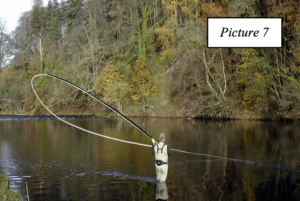 In (picture 7) you can see the D Loop beginning to form as the water skier effect continues downstream to meet the fly and leader in the anchor point position. Once the D Loop is maximized i.e. the water skier has stopped, you will then have the maximum amount of casting weight available to you (fly line in your D Loop) as shown in (picture 6). This will now enable you to deliver a very efficient forward cast (picture 8). At this stage (when in attendance) the D Loop will be assisted by the downstream wind (which is one of the main reasons we are using this cast in the first place). A downstream wind can influence your D loop in a very positive way by blowing it up like a big balloon, assisting with line tension, keeping the fly line away from you during the set up of the cast, (and the forward delivery) and ultimately keeping everything safe and comfortable throughout the cast. This cast will generally be a much more efficient cast than the one you would make if there was no wind in attendance. From this position everything should now be under tension ready to deliver the forward cast!
In (picture 7) you can see the D Loop beginning to form as the water skier effect continues downstream to meet the fly and leader in the anchor point position. Once the D Loop is maximized i.e. the water skier has stopped, you will then have the maximum amount of casting weight available to you (fly line in your D Loop) as shown in (picture 6). This will now enable you to deliver a very efficient forward cast (picture 8). At this stage (when in attendance) the D Loop will be assisted by the downstream wind (which is one of the main reasons we are using this cast in the first place). A downstream wind can influence your D loop in a very positive way by blowing it up like a big balloon, assisting with line tension, keeping the fly line away from you during the set up of the cast, (and the forward delivery) and ultimately keeping everything safe and comfortable throughout the cast. This cast will generally be a much more efficient cast than the one you would make if there was no wind in attendance. From this position everything should now be under tension ready to deliver the forward cast!
Note:
You will notice in (picture 6) how the fly line is climbing into the D Loop, keeping most of the fly line off the water surface. This is the result of the spiral staircase analogy (as mentioned in The Downstream Sweep Further Information on page 2). Let’s take a closer look! As you start the downstream sweep, (to ultimately create your D Loop) begin with the rod tip low, (e.g. the bottom step of the spiral staircase) this allows you to climb this imaginary spiral staircase during the downstream sweep (see pictures 4, 5, & 6, in sequence). It also allows you to maintain line tension throughout, whilst at the same time, releasing the maximum amount of line from the surface of the water in an upward direction. By continuing up this imaginary spiral staircase, to the top step, you will not only maximize your D Loop, but also keep it clear of the water surface for a more efficient cast. “Do not cut any corners whilst climbing up this staircase”.
The Forward Delivery
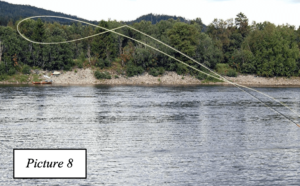 As always, the forward cast should be delivered with a smooth progressive acceleration to a stop, approximately 45° at the front (picture 8) with the rod tip slightly canted out to the side from the outset (pictures 6&7). You should also try to maintain a straight line path, parallel to the water, whilst travelling through the forward stroke (don’t swing or bowl the delivery as discussed in the D Loop section on page 3 as this will cause a tracking fault). When learning these casts for the first time, this stopping of the rod tip at 45o should only alter if the wind is blowing from an awkward direction e.g. still blowing downstream, but also coming in toward you, in which case you may have to direct the forward stroke in a slightly downward plane (but still in a straight line) to cut into the wind better and take advantage of the least wind affected area. This thankfully does not happen too often, but it does happen. Finally, after the forward stop and the fly line and fly are on their way, lower the rod tip at the same speed as the fly line, leader and fly begin to fall for a good presentation. You have now delivered a successful Double Spey cast.
As always, the forward cast should be delivered with a smooth progressive acceleration to a stop, approximately 45° at the front (picture 8) with the rod tip slightly canted out to the side from the outset (pictures 6&7). You should also try to maintain a straight line path, parallel to the water, whilst travelling through the forward stroke (don’t swing or bowl the delivery as discussed in the D Loop section on page 3 as this will cause a tracking fault). When learning these casts for the first time, this stopping of the rod tip at 45o should only alter if the wind is blowing from an awkward direction e.g. still blowing downstream, but also coming in toward you, in which case you may have to direct the forward stroke in a slightly downward plane (but still in a straight line) to cut into the wind better and take advantage of the least wind affected area. This thankfully does not happen too often, but it does happen. Finally, after the forward stop and the fly line and fly are on their way, lower the rod tip at the same speed as the fly line, leader and fly begin to fall for a good presentation. You have now delivered a successful Double Spey cast.
Improving Your Cast
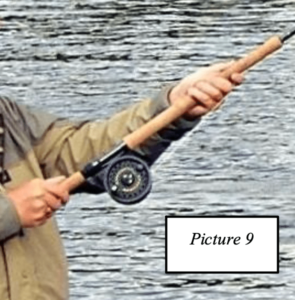 To get the most from all of our casts we need to be able to bend and unbend the rod correctly throughout the set up of these casts (smoothly and progressively). We can do this much more efficiently once we understand our equipment a little better. For teaching purposes I like to think of the fly rod as a long flexible spring, and to make this spring bend we need to apply a certain amount of opposing flex to the handle of the rod. Some instructors liken this movement to a lever and explain this by saying “use the rod as both a lever and a spring”. When using a double handed rod, we utilise both hands throughout the cast to do this. Therefore if we use our hands (above and below the reel) working in opposing directions to each other throughout all movements of the cast we are be able to flex (bend) and counter flex (unbend) the rod very efficiently. So when we come to deliver the end product, (the forward cast) the rod is simply drawn forward by the top hand with a progressive acceleration (as previously discussed). I like to describe as “almost like towing a car”, because if we start too fast when towing a car then the rope will snap. This analogy encourages us to pick up the tension of the fly line first before introducing the bottom hand to finish off the cast, ultimately stopping the rod tip at 45° at the end of the forward stroke. The rods spring will then unbend (unload) automatically to catapult the fly line out and across the river. Imagine these movements as around 80% drawing the rod forward (lead) and around 20% spring (speed). These movements will be assisted by you as you pull your bottom hand in progressively faster toward the end of the forward stroke (picture 9).
To get the most from all of our casts we need to be able to bend and unbend the rod correctly throughout the set up of these casts (smoothly and progressively). We can do this much more efficiently once we understand our equipment a little better. For teaching purposes I like to think of the fly rod as a long flexible spring, and to make this spring bend we need to apply a certain amount of opposing flex to the handle of the rod. Some instructors liken this movement to a lever and explain this by saying “use the rod as both a lever and a spring”. When using a double handed rod, we utilise both hands throughout the cast to do this. Therefore if we use our hands (above and below the reel) working in opposing directions to each other throughout all movements of the cast we are be able to flex (bend) and counter flex (unbend) the rod very efficiently. So when we come to deliver the end product, (the forward cast) the rod is simply drawn forward by the top hand with a progressive acceleration (as previously discussed). I like to describe as “almost like towing a car”, because if we start too fast when towing a car then the rope will snap. This analogy encourages us to pick up the tension of the fly line first before introducing the bottom hand to finish off the cast, ultimately stopping the rod tip at 45° at the end of the forward stroke. The rods spring will then unbend (unload) automatically to catapult the fly line out and across the river. Imagine these movements as around 80% drawing the rod forward (lead) and around 20% spring (speed). These movements will be assisted by you as you pull your bottom hand in progressively faster toward the end of the forward stroke (picture 9).
About the Bottom Hand
When you are first learning any of the Spey casts with the double handed rod don’t put too much emphasis (in the beginning) on introducing the bottom hand to the cast as this can often totally ruin your cast from the outset. The reason I say this is because (in my opinion) it is much more important to be able to create a very smooth cast before introducing the bottom hand. This is because people tend to pull the bottom hand in too hard at the beginning of the cast (when first told to use it) and this can cause all sorts of problems. More often than not, your bottom hand will begin to work automatically and in my many years of teaching I have found this to be a very good approach to getting people casting well. Obviously the bottom hand must be introduced eventually as it is this hand that will ultimately improve your cast (as explained above). However try to introduce it gradually and once you begin to relax and both hands are doing their thing you will be wondering what all the fuss was about and your bottom hand will tuck under naturally at the end of your forward stroke as you progressively accelerate it back in toward you (picture 9).
Shooting Line
Once your cast is going reasonably well and not before, you may want to introduce a little more distance into your delivery as there will be times (in certain situations) where this will definitely be a requirement. However, I should point out at this stage that unless you know the beat you are fishing quite well and you know for a fact that the fish tend to hold up reasonably far out in the river, or even near the opposite bank, it is often unnecessary to make these long casts as the fish will hold up closer to your own bank than you may think (always fish a short line first). That said if distance is a requirement, shooting line into the cast correctly then becomes a factor. Here are a few things to take into consideration to help you get the best from your casts, especially if you do need to cast a fair amount of line, which is sometimes required on certain rivers.
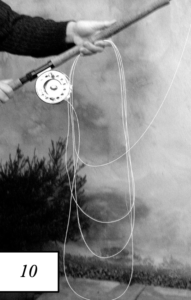 (a) Line Management: If you intend to cast a reasonable distance, you will inevitably have at your feet, several yards (metres) of fly line, not only hanging from your reel, but also being dragged downstream by the current or flow. This additional fly line must now be efficiently managed by you to prevent the current, flow, surface tension etc, from gripping it and holding it back during the shooting process, as this will prevent a slick delivery and ultimately reduce distance. To do this, whilst drawing in your fly line (prior to recasting) make sure it is drawn back in ever decreasing loops, i.e. during this drawing back process always start with the largest loop first working down to the smallest loop (picture 10). This is so that when you deliver the forward cast, the smallest loop will shoot first and the largest loop last, this helps to reduce the chance of tangling during the forward delivery. At this stage you may find that your loops of fly line (dependant on which hand you have drawn it in with) are held in your upper hand (picture 10). If this is the case it is a good idea to now transfer these loops of line to your lower hand and then draw them all back behind your fly reel, gripping them against the lower part of the rod handle (cork) using only one or two fingers to do so, usually your index finger and possibly the one next to it if you wish to use two, (picture 11).
(a) Line Management: If you intend to cast a reasonable distance, you will inevitably have at your feet, several yards (metres) of fly line, not only hanging from your reel, but also being dragged downstream by the current or flow. This additional fly line must now be efficiently managed by you to prevent the current, flow, surface tension etc, from gripping it and holding it back during the shooting process, as this will prevent a slick delivery and ultimately reduce distance. To do this, whilst drawing in your fly line (prior to recasting) make sure it is drawn back in ever decreasing loops, i.e. during this drawing back process always start with the largest loop first working down to the smallest loop (picture 10). This is so that when you deliver the forward cast, the smallest loop will shoot first and the largest loop last, this helps to reduce the chance of tangling during the forward delivery. At this stage you may find that your loops of fly line (dependant on which hand you have drawn it in with) are held in your upper hand (picture 10). If this is the case it is a good idea to now transfer these loops of line to your lower hand and then draw them all back behind your fly reel, gripping them against the lower part of the rod handle (cork) using only one or two fingers to do so, usually your index finger and possibly the one next to it if you wish to use two, (picture 11). 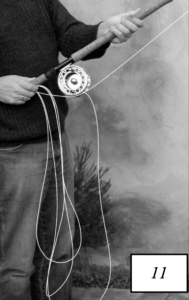 This technique will help to prevent the fly line from tangling around your reel during the forward delivery of the cast and will also allow for an easier release. You can now let go of the fly line with your upper hand (picture 11). To help you create the correct loop sizes, (which will be dependant on the amount of line you have to manage) count the pulls you make whilst drawing in your fly line e.g. in this case 1,2,3,4 pulls, hold the 1st loop, then 1,2,3 pulls, hold the 2nd loop, then 1,2 pulls, hold the 3rd loop, and finally 1 pull, hold the final loop. In this example, you should now have four loops in your hand, each one smaller than the previous one, these loops can now be drawn back behind the reel and held against the rod handle (as indicated above) ready to be delivered into the forward cast (picture 11).
This technique will help to prevent the fly line from tangling around your reel during the forward delivery of the cast and will also allow for an easier release. You can now let go of the fly line with your upper hand (picture 11). To help you create the correct loop sizes, (which will be dependant on the amount of line you have to manage) count the pulls you make whilst drawing in your fly line e.g. in this case 1,2,3,4 pulls, hold the 1st loop, then 1,2,3 pulls, hold the 2nd loop, then 1,2 pulls, hold the 3rd loop, and finally 1 pull, hold the final loop. In this example, you should now have four loops in your hand, each one smaller than the previous one, these loops can now be drawn back behind the reel and held against the rod handle (as indicated above) ready to be delivered into the forward cast (picture 11).
(b) Releasing line: The timing when releasing your fly line into the forward cast can also cause major problems, the most common of which is to release the line too early, loosing line tension and worst case scenario, causing the forward casting loop to collapse in the air. This is a common fault and one we have all been guilty of at some point, especially when using some of the specialized Spey casting lines (which are basically weight forward lines) on the market today, many of which are designed with very thin running line that can easily slip from your control unexpectedly when delivering the cast, although when used correctly they can also achieve great distances where required. “Try to release your running line as late as possible”.
(c) Trajectory: The path of the fly line is also very important, especially when distance is your ultimate goal and therefore height now becomes a major factor. By ensuring that the rod tip stops at 45° at the front before releasing line, you are giving your fly the best opportunity of reaching its intended target whilst still displaying a good turnover (especially where distance is a requirement). The lower the trajectory of the fly line e.g. travelling downward from the rod tip, the earlier it will hit the water, and if it hits the water before your leader and fly have fully extended then the cast will fail (land in a heap). As discussed earlier the only time that a lower cast should be encouraged is if you were casting into a wind for a relatively short to medium cast, but when distance is a requirement, this would be a disadvantage as the more line you attempt to deliver, the more height you will ultimately need to achieve the required turnover of your fly line leader and fly.
Casting Styles
There are many different casting styles you will observe along the river, as well as variations of casts too (especially for this particular cast). Some anglers prefer to draw an arc with their rod (starting from the fished out position downstream) across the front of their body, taking the rod tip to a position of 180° upstream of where they started from (i.e. directly opposite their rod tips initial starting position). This gives them the advantage of a closer anchor point than alternative methods, allowing them to create a larger D loop where room is available. Some prefer to draw their fly upstream (after the initial lift) and then downstream again (spiral staircase) whilst swivelling their body to do so, others prefer not to turn their bodies at all and simply cross their hands over during the upstream sweep, uncrossing them again during the downstream sweep, all of these techniques are fine, as long as they are facing their intended target (with hands uncrossed) as they are about to deliver their cast. This will put them in a strong position to realise the full potential of their cast (as discussed on page 1. Once your own cast is going well, don’t try to copy someone else’s style, even though this may come in the form of well intended advice, it will often end in disaster because you will inevitably inherit all of their bad habits too. “If it’s not broken then there’s no need to fix it”. Then there’s my own personal rule: Never force you’re style of casting upon anyone else. As a full time instructor this is something I feel very strongly about, everyone is built differently and there will be a style that suits the individual. Whatever style, or variation of cast for that matter, that you choose to adopt, it will only work efficiently if the mechanics within that style are correct (standard set of rules). It is these mechanics that you must thoroughly understand to get the best from your casting style. Once this is achieved you can then use several variations of these casts to combat the many and varying situations you will encounter on many rivers.
Throughout this article I have predominantly shown the Double Spey cast with the left hand up off the left bank, this is not only for continuity, but also because I am very aware that the majority of anglers out there are predominantly right handed (as I am) and therefore the left hand tends to get neglected. Left handed casters have the same inherent phobia and tend to neglect their right hand, but believe me it makes no difference to the outcome of the cast whichever hand you need to employ above and below the reel for the purposes of creating the most efficient cast, this is because the mechanics of the cast, whichever side of the river you may be fishing from, are exactly the same. The only thing I would reiterate at this point is “try to avoid your hands being crossed over when delivering the cast” (as explained on Page 1). This encourages tracking problems during the forward delivery, as your hands inevitably want to return to the side of your body they belong to. Yes some casters have perfected this method, but I would argue that where distance is a requirement, those casters who open up to the cast correctly at the point of delivery will ultimately prevail.
The simple fact is that most anglers try to avoid using their non dominant hand where possible and therefore do not get the required practice to make them efficient from both banks. I urge you all to put some time in with this cast from both banks, left handed casters from the right bank and right handed casters from the left bank. I can assure you that if you put this time in (using the correct mechanics) it will eventually mould you into a good all round caster, enabling you to confidently address many of the situations on the river you may have found difficult in the past.
In the final article (article 6) we will take a look at the Snake Roll cast which is not only an alternative downstream wind cast to the Double Spey, but can also be a very useful and dynamic cast in it’s own right and one you should familiarise yourselves with to get the most from your fishing.
